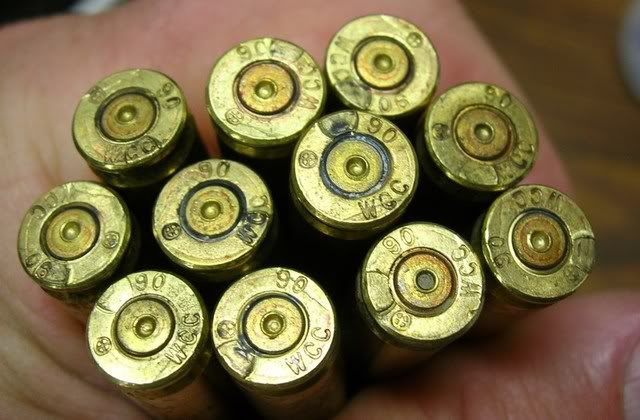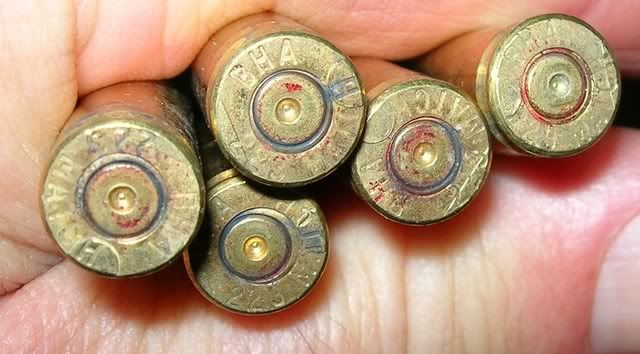

 The Accurate Reloading Forums
The Accurate Reloading Forums  THE ACCURATE RELOADING.COM FORUMS
THE ACCURATE RELOADING.COM FORUMS  Guns, Politics, Gunsmithing & Reloading
Guns, Politics, Gunsmithing & Reloading  Reloading
Reloading  Pressure signs, sticky bolt...
Pressure signs, sticky bolt...Go  | New  | Find  | Notify  | Tools  | Reply  |  |
| one of us |
Hi, my Tikka T3 Lite is quite accurate and pleasant, but during load development I get very soon sticky bolt lift as well as some marks on the head stamp:  I'm puzzled, since the primers always seem to have a regular aspect, the spent cases are easy to extract and the loads are far from the max suggested; the COL is within the SAAMI max too. What is your opinion? | ||
|
| One of Us |
If the bolt lugs have dented the receiver, then the bolt gets stuck with wimpy loads. | |||
|
| One of Us |
From what I have observed, Wizzums are rough on brass. | |||
|
| one of us |
Sometimes when a resizing die is overworking the brass and you leave alot of headspace it can give you early signs of pressure. Is it possible that you die is bumping the shoulder back alot more than the ideal space of say .001"-.003"? By the way...what are the loads that are doing this?? | |||
|
| One of Us |
Unfortunately primers are unreliable indicators of pressure. You can have flat primers with light loads, rounded primers that leak. Reading primers is on the same level as reading tea leaves, you see what you want, except, you don’t get a good cup of tea. I highly recommend using a chronograph when developing loads. If you are getting stiff bolt lift and the velocities are low, something may be wrong with the rifle. If you are getting stiff bolt lift and the velocities are high, well guess what, pressures are also high. The typical pressure signs of sticking bolt lift, leading primers, blown primers, pierced primers. These are gross indications of high pressure and are usually reliable indications of high pressure. I am not necessarily convinced that a shiny spot on the case head means high pressures, but it if shows up only on high end loads, it probably is an indication. Brass flow into the bolt head is a positive indication of high pressures. The attached pictures are positive indications of loads that are overpressure. These service rifle teams use these high pressure loads at long range. They have no expectation of reloading these cases. They can afford to toss bolts and barrels. They also crimp their primers so the things will at least stay in the case upon ejection. I believe I could shake a primer loose with the AMU brass. 2007 AMU long range brass.  2007 USMC Long range brass, factory loaded  | |||
|
| one of us |
I should have been more precise, the bolt was "slightly sticky" to lift and the shiny spots on the cases are quite light. The rounds were loaded with Nosler BT 140 gr, 66.5 and 67 gr of french powder SNPE Vectan SP12, virtually the same as the Ramshot Magnum; both are actually made in Belgium by PB Clermont. Quickload lists them as identical. Unfortunately I cannot find any useful data from SNPE, so, I had to rely on the last Nosler manual, that suggests 67 gr min. and 71 gr max. of Ramshot Magnum, behind the BT 140 gr. I will make some more tests at 64-66gr using my chronograph.... | |||
|
| one of us |
You have found your maximum load for your rifle. | |||
|
| One of Us |
Old age is a high price to pay for maturity!!! Some never pay and some pay and never reap the reward. Wisdom comes with age! Sometimes age comes alone.. | |||
|
| One of Us |
If you have reached the max load for the rifle, then you have reached the max load for the brass. Load the brass with the same load as before, again and again. If the brass is reloaded 5-8 or more times before the primer pockets start to loosen up, then you are probably not running a maximum pressures. When you get loose primer pockets after 1-3 firings then your right there if not over. This condition is usually accompanied by shearing of brass extruded into the ejector slot when opening the bolt(the shiny spot on the case head), but the slight ejector marks can be found on loads at normal operating pressures. It is when the brass extrudes to the point of the bolt shearing off a substantial amount of brass upon opening, that you have definitely passed in to very high pressures and the primer pocket will likely have been enlarged to the point of not holding a new primer securely. I've seen loads that exibit a new shiny ejector mark on every firing, and have had the primer pockets stay tight for over 8 firings. This was probable due to a slight burr on the ejector slot and not high pressure. Just remember that the brass is the limiting factor to the pressure question, monitoring primer pockets is a good way to indicate safe pressure levels over the course of load developement. I agree that looking at primers alone is a kin to reading tea leaves, but I think they can bea good indicator when used in conjunction with other things, such as a chronograph, looking for ejector marks, loose primer pockets. When you look at all of these things over the course of load developement, you can find trends in the deformation that the primers display within a specific lot of primers. | |||
|
| one of us |
Good post Steve! - mike ********************* The rifle is a noble weapon... It entices its bearer into primeval forests, into mountains and deserts untenanted by man. - Horace Kephart | |||
|
| one of us |
Hey wildboar, Unfortunately, the Velocity does not tell you spit about the Pressure. Too many variables in the Chamber, Bore and Cartridge(Case, Primer, Powder, Bullet) to draw any useful conclusions from looking at a Velocity. As always, if you want to know anything at all about Pressure, you must use the good-old, never-fail, always-reliable CHE&PRE which were recently proven in this thread as the only reliable Pressure Indicator. If you really think Velocity indicates Pressure, someone has mislead you badly. Best of luck with the Loads. | |||
|
| one of us |
Unless there is something very wierd about your powder there is no way you are anywhere near overpressure. | |||
|
| one of us |
HC, I've already read those posts; I certainly know that a chronograph says nothing about pressure. That belgian/french powder I used is PRESUMEDLY the same as the Ramshot Magnum; furthermore my Oehler 43 is collecting dust since a couple of years and it's a good excuse to take it to the range and carry out some velocity checks. | |||
|
One of Us |
I think yor ejector may be protruding from the bolt face a little bit....... "Bitte, trinks du nicht das Wasser. Dahin haben die Kuhen gesheissen." | |||
|
| one of us |
Nope, I've just checked... | |||
|
| one of us |
Good for you. I can understand your problem about Powder availability. Always an agravation when you have to make substitutions and discover their Limitations as the Loading progresses. Best of luck with the Loads. | |||
|
| One of Us |
Wildboar, a sticky bolt lift is normally always caused by high pressure with case set back onto the bolt face, usually accompanied by the shearing of the case head at the ejector plunger recess, as in your case. This condition can also happen with a chamber having very minimal dimensions particularly with neck length where there is no room for the slight lengthening of the case neck which happens everytime a cartridge is fired. Presumably you are making sure all case lube is cleaned off the cases and the chamber is dry. Presence of case lube or oil will also cause case setback. | |||
|
| one of us |
This hint is interesting; of course I check and, if necessary, trim the cases after each resizing, but I've always considered only the case body lengthening, rather than focusing on the neck. I'll trim them a tad shorter than usual and see what happens. BTW, ammos, chamber and barrel are always dry. BTW2, I went to the range this morning and 66 gr of that belgian/french powder, behind the BT 140 gr. gave VERY good accuracy and no high pressure signs; I couldn't use the chronograph due to crowding. | |||
|
One of Us |
I deliberately lube my loaded cases to prevent set-back and case longation. I can go from a bolt closing firm on a loaded case to opening easily (my sizer doesn't quite set the shoulder back far enough if the case was fired in another gun). I suppose different conditions could have different outcomes. Mmmm... Best not to do as I do! (But my cases do last forever!) Regards 303Guy | |||
|
| one of us |
After all, it's unlikely; I've measured the 2 said cases, not resized; both are less than 2.092" long, well below the SAAMI max. Unless my chamber is abnormally short, I don't think the neck lengthening is the culprit. | |||
|
| One of Us |
I had some problems like this and somewhere on this site I found something about the short mags not liking magnum primers and i started loading wsm's with standard primers and problems went away, I could use more powder higher velocity and no more presure signs! | |||
|
| Powered by Social Strata |
| Please Wait. Your request is being processed... |
|
 The Accurate Reloading Forums
The Accurate Reloading Forums  THE ACCURATE RELOADING.COM FORUMS
THE ACCURATE RELOADING.COM FORUMS  Guns, Politics, Gunsmithing & Reloading
Guns, Politics, Gunsmithing & Reloading  Reloading
Reloading  Pressure signs, sticky bolt...
Pressure signs, sticky bolt...

Visit our on-line store for AR Memorabilia

